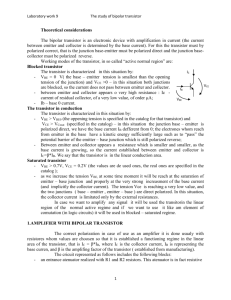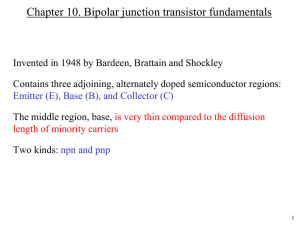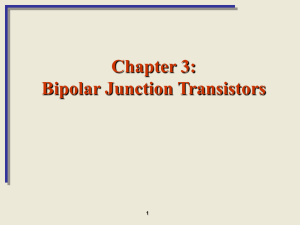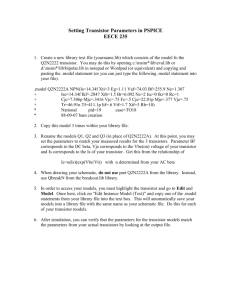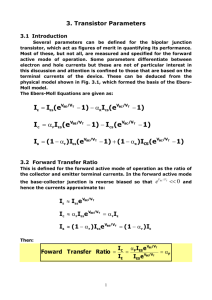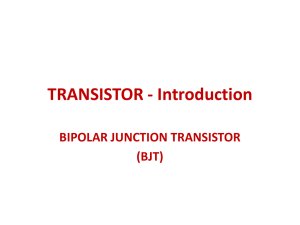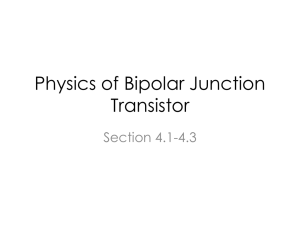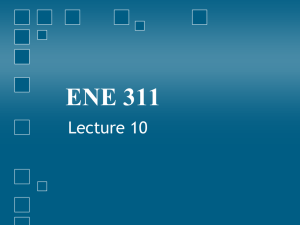Common Base Configuration
advertisement
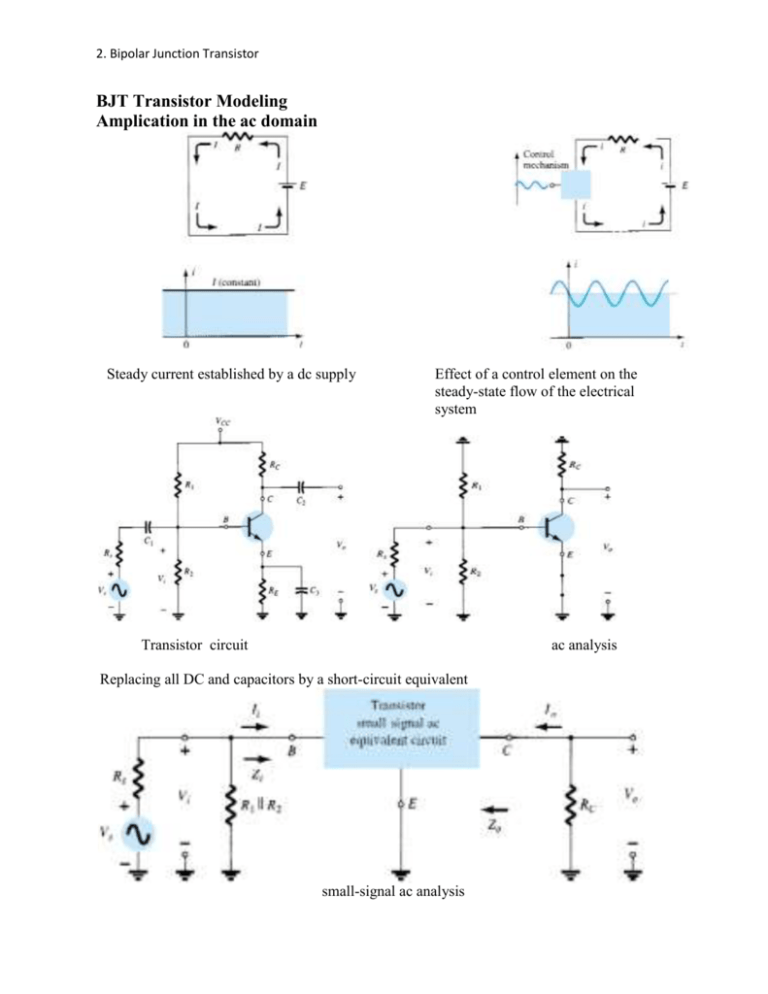
2. Bipolar Junction Transistor BJT Transistor Modeling Amplication in the ac domain Steady current established by a dc supply Effect of a control element on the steady-state flow of the electrical system Transistor circuit ac analysis Replacing all DC and capacitors by a short-circuit equivalent small-signal ac analysis 2. Bipolar Junction Transistor \ The Importance Parameters Two-port system Input impedance: Output impedance: The output impedance is determined at the output terminals looking back into the system with the applied signal set to zero. 2. Bipolar Junction Transistor Voltage Gain Current Gain 2. Bipolar Junction Transistor Determining the loaded current gain Phase relationship For the typical transistor amplifier, the input and output signals are either 180° out of phase or in phase. THE re TRANSISTOR MODEL BJT transistor amplifiers are referred to as current-controlled devices. Common Base Configuration re model 2. Bipolar Junction Transistor Typical values of the Zo are in the mega ohm range Defining Zo. (Vo and Vi are in phase) 2. Bipolar Junction Transistor Determining Zi If the applied signal is set to zero, then Ic is 0 A,resulting Impact of re on input impedance. 2. Bipolar Junction Transistor (Vo and Vi are 180̊ out of phase) Two-port system The term “term” or h-parameter was chosen because the mixture of variables( V and I) Hybrid input equivalent circuit Hybrid output equivalent circuit 2. Bipolar Junction Transistor Complete hybrid equivalent circuit Short-circuit input–impedance parameter: Open-circuit reverse transfer voltage ratio parameter: Short-circuit forward transfer current ratio parameter: Open-circuit output admittance parameter: The common emitter configuration: Ii =Ib, Io=Ic,Vi=Vbe,Vo=Vce Ie= Ib + Ic Common-emitter configuration The common base configuration: Ii=Ie, Io=Ic,Vi=Veb,Vo=Vcb Ie= Ib + Ic 2. Bipolar Junction Transistor Common base configuration Since hr is normally a relatively small quantity and resistance determined by 1/ho is often large enough, resulting Hybrid versus re model Common-emitter Configuration 2. Bipolar Junction Transistor The current source of the standard hybrid equivalent circuit is pointing down rather than in the actual direction as shown in the re model GRAPHICAL DETERMINATION OF THE h-PARAMETERS 2. Bipolar Junction Transistor 2. Bipolar Junction Transistor 2. Bipolar Junction Transistor Complete hybrid equivalent circuit for a transistor 1.5kW 10 0 Ib 33mA / V 2. Bipolar Junction Transistor BJT Small-Signal Analysis re model 1. Common Emitter (CE) Fixed-Bias Configuration Effect of ro Zo= ro||Rc Av=− 𝑟𝑜||𝑅𝑐 𝑟𝑒 Io= 1 𝑅𝑐 1 1 + 𝑅𝑐 𝑟𝑜 𝐼𝑜 𝛽𝐼𝑏 = 𝐼𝑜 𝐼𝑏 𝑟𝑜 𝑟𝑜+𝑅𝑐 𝑟𝑜.𝛽 𝛽𝐼𝑏 → 𝐼𝑜 𝐼𝑏 = 𝑟𝑜𝛽 𝑟𝑜+𝑅𝑐 𝑟𝑜𝛽 Ai= 𝐼𝑖 = 𝐼𝑏 𝐼𝑜 = (𝑟𝑜+𝑅𝑐) (≅ 1) → 𝐴𝑖 = 𝑟𝑜+𝑅𝑐 2. Bipolar Junction Transistor CE Voltage-Divider Bias Configuration R’=R1||R2= 𝑅1.𝑅2 𝑅1+𝑅2 Ib = 1 𝛽𝑟𝑒 1 1 + 𝛽𝑟𝑒 𝑅′ Zi=R’||𝛽𝑟𝑒 Io =𝛽𝐼𝑏 → Zo = Rc Ai = Av = 𝑅𝑐 − 𝑟𝑒 Effect of ro Zo = ro||Rc Av =− 𝑟𝑜||𝑅𝑐 𝑟𝑒 𝐼𝑜 𝑟𝑜. 𝛽 = 𝐼𝑏 𝑟𝑜 + 𝑅𝑐 Ai = 𝐼𝑜 𝐼𝑖 = 𝐼𝑜 𝐼𝑏 𝐼𝑏 𝐼𝑜 Or 𝑍𝑖 Ai = −𝐴𝑣 𝑅𝑐 𝑟𝑜.𝛽 = 𝑟𝑜+𝑅𝑐 𝑅′ 𝑅 ′ +𝛽𝑟𝑒 𝐼𝑜 𝐼𝑖 = 𝐼𝑖 → 𝐼𝑜 𝐼𝑏 𝐼𝑖 = 𝑅′ 𝑅 ′ +𝛽𝑟𝑒 =𝛽 𝐼𝑏 𝐼𝑜 𝐼𝑏 𝐼𝑏 𝐼𝑖 = 𝛽𝑅′ 𝑅 ′+𝛽𝑟𝑒 2. Bipolar Junction Transistor Unbypassed r Vi = Ib𝛽 re +Ie RE = Ib𝛽 re + (𝛽+1)Ib RE = (𝛽 e +(𝛽+1) RE)Ib Zb = 𝑉𝑖 𝐼𝑏 r r = 𝛽 e +( 𝛽+1)RE = 𝛽( e + RE) (for 𝛽 >>1) Ib = 1 𝑍𝑏 1 1 + 𝑍𝑏 𝑅𝐵 𝐼𝑜 Ai = 𝐼𝑖 = or Zo = Rc 𝑉𝑖 𝑍𝑏 Vo= − 𝐼𝑜. 𝑅𝑐 = −𝛽𝐼𝑏 𝑅𝑐 𝑉𝑖 𝑉𝑜 𝑍𝑏 𝑉𝑖 =− 𝑅𝑐 𝑟𝑒+𝑅𝐸 Effect of ro For typical parameter values the effect of ro can be ignored Bypassed If RE is bypassed by an emitter capacitor CE, then Zb = 𝛽. re Av =− 𝑅𝑐 𝑟𝑒 𝐼𝑖 𝐼𝑜 𝐼𝑏 𝐼𝑏 𝐼𝑖 = 𝑅𝐵 = 𝑅𝐵+𝑍𝑏 Io = 𝛽𝐼𝑏 → 𝐼𝑏 = 𝛽 Zi = RB || Zb Vo= −𝛽( )Rc → 𝐴𝑣 = 𝐼𝑏 𝐼𝑜 r ≅ 𝛽RE (for RE >> e) Ib = 𝐼𝑖 → 𝛽.𝑅𝐵 𝑅𝐵+𝑍𝑏 2. Bipolar Junction Transistor Common Collector ( Emitter Follower) Configuration 2. Bipolar Junction Transistor COMMON-BASE CONFIGURATION 𝑉𝑖 Vo= Io Rc = ( Ic )Rc =𝛼Ie.Rc =𝛼 ( ) 𝑅𝑐 → 𝐴𝑣 re (since 𝛼 ≅ 1) Ie ≅ 𝐼𝑖 ( for RE>>re) Io = −𝐼𝑐 = − 𝛼Ie = − 𝛼Ii→ 𝐴𝑖 = − 𝛼 ≅ −1 Effect of ro For typical parameter values the effect of ro can be ignored APPROXIMATE HYBRID EQUIVALENT CIRCUIT 2. Bipolar Junction Transistor common-emitter hie =𝛽re hie =𝛽re common-base hoe = 1/ro hfb =𝛼 Common Emitter (CE) Fixed Bias Configuration Zi =RB Zo=RC ||hie 𝑉𝑖 (ℎ𝑖𝑒 ) RC VO = -IoRC = hfe Ib RC = - hfe Ib ≅ Ii Io = hfe Ii Effect of ro 1 Hoe = 𝑟𝑜 ( for RB >> hie hfe AV = - ℎ 𝑓𝑒 𝑅𝑐 ℎ𝑖𝑒 hib = re 2. Bipolar Junction Transistor 1 Zo = ℎ𝑜𝑒 || Rc re = ℎ𝑖𝑒 ℎ𝑓𝑒 Av = - 𝒉𝒇𝒆( 𝟏 ||𝑹𝒄) 𝒉𝒐𝒆 𝒉𝒊𝒆 CE Voltage – Divider – Bias Configuration CE Emitter –Bias Configuration Unbypassed 2. Bipolar Junction Transistor Common Collector (Emitter Follower) Configuration Common Base Configuration 2. Bipolar Junction Transistor Zi = RE||h ib Zo = Rc 𝑉𝑖 Ie = h ib 𝑉𝑖 Vo =−𝐼𝑜. 𝑅𝑐 = −(ℎ𝑓𝑏. 𝐼𝑒)𝑅𝑐 = = −ℎ𝑓𝑏 (h ) 𝑅𝑐 → 𝐴𝑣 = − ib Ai = 𝐼𝑜 Ii ℎ𝑓𝑏.𝐑𝐜 h ib = hfb System Aprroach- Effect Of Rs And RL Fixed Bias V CC RC RB RC Zi = RB|| 𝛽re Zo = Rc 𝑉𝑜 𝑅𝐿||𝑅𝑐 Av = = − Vi re 𝐼𝑜 𝑍𝑖 Ii = Is→ 𝐴𝑖 = Ii = −𝐴𝑣 𝑅𝐿 Voltage Divider Bias Vi = 𝑍𝑖 𝑍𝑖+𝑅𝑠 Avs = 𝑉𝑜 Vs = 𝑉𝑠 → 𝑉𝑖 𝑉𝑜 Vs Vi 𝑉𝑖 𝑉𝑠 = = 𝑍𝑖 𝑍𝑖+𝑅𝑠 𝑍𝑖 Zi+Rs Av RL 2. Bipolar Junction Transistor CE Unbypass Emitter Bias Emitter Follower Network R’E = RE||RL Vs –𝐼𝑏.Rs – 𝐼𝑏𝛽𝑟𝑒 − (𝛽+1)Ib R’E = 0 → 𝐼𝑏 = Ie 𝜷𝑰𝑏 = 𝑉𝑠 Rs +𝑟𝑒+𝑅 ′ 𝐸) β 𝑉𝑠 Rs+𝛽𝑟𝑒+(𝛽+1)𝑅′𝐸 ≅ 𝑉𝑠 Rs+𝛽(𝑟𝑒+𝑅 ′ 𝐸) 2. Bipolar Junction Transistor Vo = Rs β 𝑅′ 𝐸 +𝑟𝑒+𝑅 ′ 𝐸 Zo = RE || ( Rs β vs → Avs = Rs β 𝑅′ 𝐸 Zb = 𝛽𝑟𝑒 + (𝛽 + 1)𝑅′ 𝐸 ≅ 𝛽(𝑟𝑒 + 𝑅′ 𝐸) +𝑟𝑒+𝑅 ′ 𝐸 + 𝑟𝑒 ) Zi = RB ||Zb Common Base Network Av ≅ Philips Semiconductors NPN general purpose transistors 𝑅𝐿||𝑅𝑐 re Product specification BC 107;BC 108;BC;109 2. Bipolar Junction Transistor PINNING FEATURES PIN DESCRIPTION 1 emitter 2 base 3 Collector,connected the case Low current (max. 100mA) Low voltage ( max. 45 V) APPLICATIONS General purpose switching and amplification DESCRIPTIONS NPN transistor in a TO-18;SOT 18 metal package PNP complement : BC177 Characteristic T = 25 C, unless other wise specified symbol parameters IcBc Collector cut-off current IeBc hFE hFE VCEsat VBEsat VBE Emitter cut-off current DC current gain BC 107A; BC108A BC107B; BC108B; BC109B BC109C; BC109C DC current gain BC 107A; BC108A BC107B; BC108B;BC109B BC109C; BC109C conditions IE = 0; VCB = 20 V IE = 0; VCB = 20 V; T = 125 C Ic = 0; VEB = 5 V Ic = 10μA;VcE = 5 V Ic = 2 mA;VcE = 5 V Collector emitter saturation voltage Ic = 10 mA; IB = 0,5 mA Ic = 100 mA; IB = 5 mA Base emitter saturation voltage Ic = 10 mA; IB = 0,5 mA;note 1 Ic = 100 mA; IB = 5 mA;note 1 Base emitter voltage Ic = 2 mA; VcE = 5 V; note 2 Ic = 10 mA; VcE = 5 V; note 2 min - type - max 15 15 unit nA - - 50 nA 40 100 90 150 270 - 110 200 420 180 290 520 220 450 800 550 - 90 200 700 900 620 - 250 600 700 770 μA mV mV mV mV mV mV 2. Bipolar Junction Transistor Cc Ce fT F F Collector capacitance Emitter capacitance transition frecuency Noise figure BC109B;BC109C Noise figure BC 107A; BC108A BC107B; BC108B; BC108C BC109B; BC109C NOTES IE = ie = 0; VCB =10 V; f = 1 MHZ IC= ic = 0; VEB =0,5 V; f = 1 MHZ IC= 10mA; VCB =5 V; f = 100 MHZ Ic = 200μA;VcE = 5 V;Rs = 2 kΩ f = 30 Hz to 15.7 kHz Ic = 200μA;VcE = 5 V;Rs = 2 kΩ; F = 1kHz;B = 200Hz 1. VBEsat decrease by about 1.7 mV/K with increasing temperature 2. VBE decrease by about 2 mV/K with increasing temperature 100 2.5 9 - 6 - pF pF MHz - - 4 dB - - 10 4 dB dB 2. Bipolar Junction Transistor
